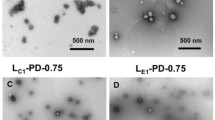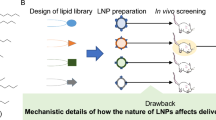Abstract
There is a need of an efficient and safe non-viral gene delivery carrier due to promising future of nucleic acid-based therapeutics in the treatment of intractable diseases. Cytotoxicity and cost are the major concerns with current quaternary ammonium-based cationic liposomes. The major aim of current research work was development and in vitro evaluation of arginine-anchored nanoliposomes for gene delivery. l-Arginine–fatty acid conjugate was synthesized and characterized using IR, NMR, and mass spectroscopy. Synthesized conjugate—lauroyl arginine ethyl ester (LAE) was successfully incorporated into liposomes. Effect of nanocarrier composition on DNA binding was evaluated by preparing solid lipid nanoparticle (SLN) and self nanoemulsifying system (SNES) using same LAE concentration. Effect of cationic head on DNA binding was also evaluated. Arginine-anchored nanoliposomes—arginoplexes (APX) showed superior DNA-binding affinity. Surface PEG was expected to cause hindrance in DNA binding in SLNs and SNES. Guanidino group was found to be a better cationic head for DNA binding compared to primary amine or quaternary amine. Gel retardation assay was performed to optimize the ratio of DNA to LAE in nanocarrier. Serum stability, haemolysis, cytotoxicity, and transfection studies were carried out to evaluate APX. Binding of DNA to APX was found to be stable in the presence of serum, and no degradation of DNA was observed. APX containing 2 mg/ml LAE which exhibited particle size of ~72 nm with zeta potential of +57.5 mV, showed lower cytotoxicity and better transfection. APX can be a promising carrier for gene delivery.








Similar content being viewed by others
References
Curiel DT, Wagner E, Cotten M, Birnstiel ML, Agarwal S, Li CM, Loechel S, Hu PC (1992) High-efficiency gene transfer mediated by adenovirus coupled to DNA–polylysine complexes. Hum Gene Ther 3:147–154
De Smedt SC, Demeester J, Hennink WE (2000) Cationic polymer based gene delivery systems. Pharm Res 17:113–126
Dobson J (2006) Gene therapy progress and prospects: magnetic nanoparticle-based gene delivery. Gene Ther 13:283–287
Evans C, Robbins P (1995) Current concepts review: possible orthopaedic applications of gene therapy. J Bone Jt Surg A 77:1103–1115
Felgner JH, Kumar R, Sridhar C, Wheeler CJ, Tsai YJ, Border R, Ramsey P, Martin M, Felgner PL (1994) Enhanced gene delivery and mechanism studies with a novel series of cationic lipid formulations. J Biol Chem 269:2550–2561
Kai E, Slack NL, Ayesha A, Evans HM, Lin AJ, Samuel CE, Safinya CR (2004) Cationic lipid–DNA complexes for gene therapy: understanding the relationship between complex structure and gene delivery pathways at the molecular level. Curr Med Chem 11:133–149
Kerwin BA (2008) Polysorbates 20 and 80 used in the formulation of protein biotherapeutics: structure and degradation pathways. J Pharm Sci 97:2924–2935
Lasic DD, Needham D (1995) The “stealth” liposome: a prototypical biomaterial. Chem Rev 95:2601–2628
Liu F, Huang L (2002) Development of non-viral vectors for systemic gene delivery. J Control Release 78:259–266
Liu Y, Mounkes LC, Liggitt HD, Brown CS, Solodin I, Heath TD, Debs RJ (1997) Factors influencing the efficiency of cationic liposome-mediated intravenous gene delivery. Nat Biotechnol 15:167–173
Lv H, Zhang S, Wang B, Cui S, Yan J (2006) Toxicity of cationic lipids and cationic polymers in gene delivery. J Control Release 114:100–109
Mccormick F (2001) Cancer gene therapy: fringe or cutting edge? Nat Rev Cancer 1:130–141
Patel K, Padhye S, Nagarsenker M (2012) Duloxetine HCl lipid nanoparticles: preparation, characterization, and dosage form design. AAPS PharmSciTech 13:125–133
Patel K, Patil A, Mehta M, Gota V, Vavia P (2013) Medium chain triglyceride (MCT) rich, paclitaxel loaded self nanoemulsifying preconcentrate (PSNP): a safe and efficacious alternative to Taxol®. J Biomed Nanotechnol 9:1996–2006
Sun X, Zhang N (2010) Cationic polymer optimization for efficient gene delivery. Mini Rev Med Chem 10:108–125
Takehara M (1989) Properties and applications of amino acid based surfactants. Colloids Surf 38:149–167
Thomas CE, Ehrhardt A, Kay MA (2003) Progress and problems with the use of viral vectors for gene therapy. Nat Rev Genet 4:346–358
Acknowledgments
Authors are thankful to University Grant Commission (UGC), Government of India, for financial assistance, and AICTE-NAFETIC for providing facilities to perform the experimental work.
Conflict of interest
Authors declare no conflict of interest.
Author information
Authors and Affiliations
Corresponding author
Rights and permissions
About this article
Cite this article
Patel, K., Tyagi, M., Monpara, J. et al. Arginoplexes: an arginine-anchored nanoliposomal carrier for gene delivery. J Nanopart Res 16, 2345 (2014). https://doi.org/10.1007/s11051-014-2345-y
Received:
Accepted:
Published:
DOI: https://doi.org/10.1007/s11051-014-2345-y




